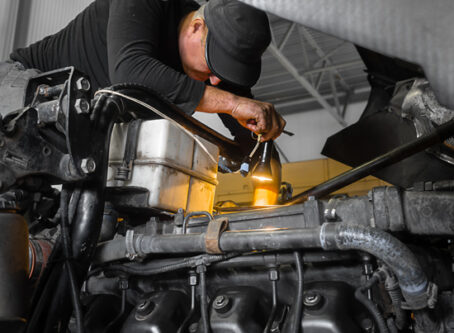Heavier trucks mean heavier burden
Here’s an apt example of how the virus of longer, heavier trucks gets started and spreads.
Larry Luick is a North Dakota state senator. He also owns a farm near the South Dakota state line. Luick is keenly aware South Dakota allows full-length doubles on its highways but North Dakota does not.
“If (drivers) want to drop grain in North Dakota, they have to unhook, drop or go and dump the first trailer. Then they have to come back and unhook, hook onto another trailer and go into North Dakota and dump the second trailer,” Luick told Fleet Owner Magazine. “We can do better.”
You bet we can. Get South Dakota to disallow full-length doubles, and we’ll all be on the same page.
But that’s not how it works. Instead, Luick wants North Dakota to allow those long doubles. And not just that. Luick thinks North Dakota should do South Dakota one better by allowing more than two full-length trailers at a time. Luick wants North Dakota to launch a truck-train pilot program, and he has reportedly persuaded some of his fellow senators.
According to Fleet Owner, a North Dakota pilot program could attract “buy-in from … such areas as South Dakota, Minnesota, and perhaps even the Canadian province of Manitoba.”
If that does happen, you can bet a grain shipper in Montana, which borders North Dakota to the west, will complain that truck-trains from North Dakota have to stop and drop a third full-length trailer at the border. How terribly inefficient, they’ll complain. “We can do better,” they’ll tell their legislators.
‘Better’ will mean truck trains in Montana state too.
Is this likely to happen? Maybe, maybe not. But it has happened before and with the help of some in our industry. Consider Dart Transit, North America’s 23rd largest truckload fleet, according to Transport Topics. The St. Paul, Minn., carrier has long promoted bigger trailers.
“I remember going state to state in the early 1980s as part of a coalition explaining the reasoning and the benefits for extending trailer length beyond what was the 48-foot standard at the time,” said Dart chairman Donald Oren in a Transport Topics essay in 2019. “A large part of those efforts involved talking to legislators, governors, shippers and safety advocates to legalize 53-foot trailers on our nation’s highways.”
Earlier, Dart pioneered 48-foot and then 53-foot high-cube trailers.
In increments of a few feet at a time, over the course of a decade or so, we went from 40-foot trailers to 53-foot trailers – a 32% increase. Each change made it just a little harder for drivers to navigate local streets and forced many small carriers to buy new, longer trailers they did not otherwise need.
And how necessary are those 53-footers? We don’t really know. There are no statistics on load factors that would tell us how many (or few) 53-foot trailers on the road are loaded to capacity and how many carry loads significantly less than their maximum cube and weight limitations.
Meanwhile, there’s an effort to increase weight limits in Indiana.
The current 80,000-pound limit isn’t enough for some lawmakers, who want to raise it to 120,000.
What about public roads and public safety?
Don’t worry, say proponents of truck trains. They’ll put more axles under trucks to distribute the weight and protect the roadways. The brakes will stop heavier trucks as quickly or more quickly than current vehicles, they say. The entire state of Indiana will benefit from increased productivity – especially agricultural interests, the masonry industry, and probably other shippers as well, for whom it will mean cash in their pockets.
That’s swell, except when all those axles are on a single bridge span that has to bear the entire 120,000 pounds – 60 tons. And those brakes? Maybe they’ll stop the truck, but they won’t necessarily stop the cargo, which can keep going, possibly crushing the driver. Steel in rolls, pipe, and construction beams come to mind.
Other cargo will be dangerous at those heavy weights. Actually, most all cargo at that weight will be dangerous in motion. How about one of those snow-storm pileups that catch virtually everyone off guard? A 120,000-pound truck could crush a lot of other vehicles. Care to think what could happen should the driver of such a rolling monster fall asleep at the wheel? I don’t either.
As if the physical implications of 120,000-pound trucks aren’t enough, there’s one of the reasons given to justify them: the so-called driver shortage.
Can’t find enough drivers? Have the drivers you can find pull more cargo.
Of course, there would be plenty of drivers if the pay were high enough, but in this case industries would apparently rather operate fundamentally unsafe equipment than raise driver pay.
Bills that would allow those 60-ton trucks are currently in the Indiana legislature.
OOIDA Executive Vice President Lewie Pugh recently wrote to Indiana lawmakers. His comment could apply to North Dakota too.
“Of course, shippers would like to move more product at the same or even lower cost. That is the nature of business,” Lewie wrote. “But they don’t have to be concerned about highway damage or public safety. That is your job, and you have a responsibility to the public that includes safety and care of state resources.”
Let’s hope they take that job seriously. LL









